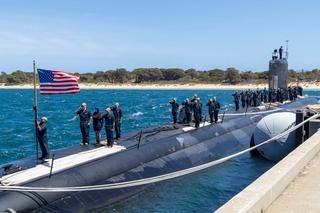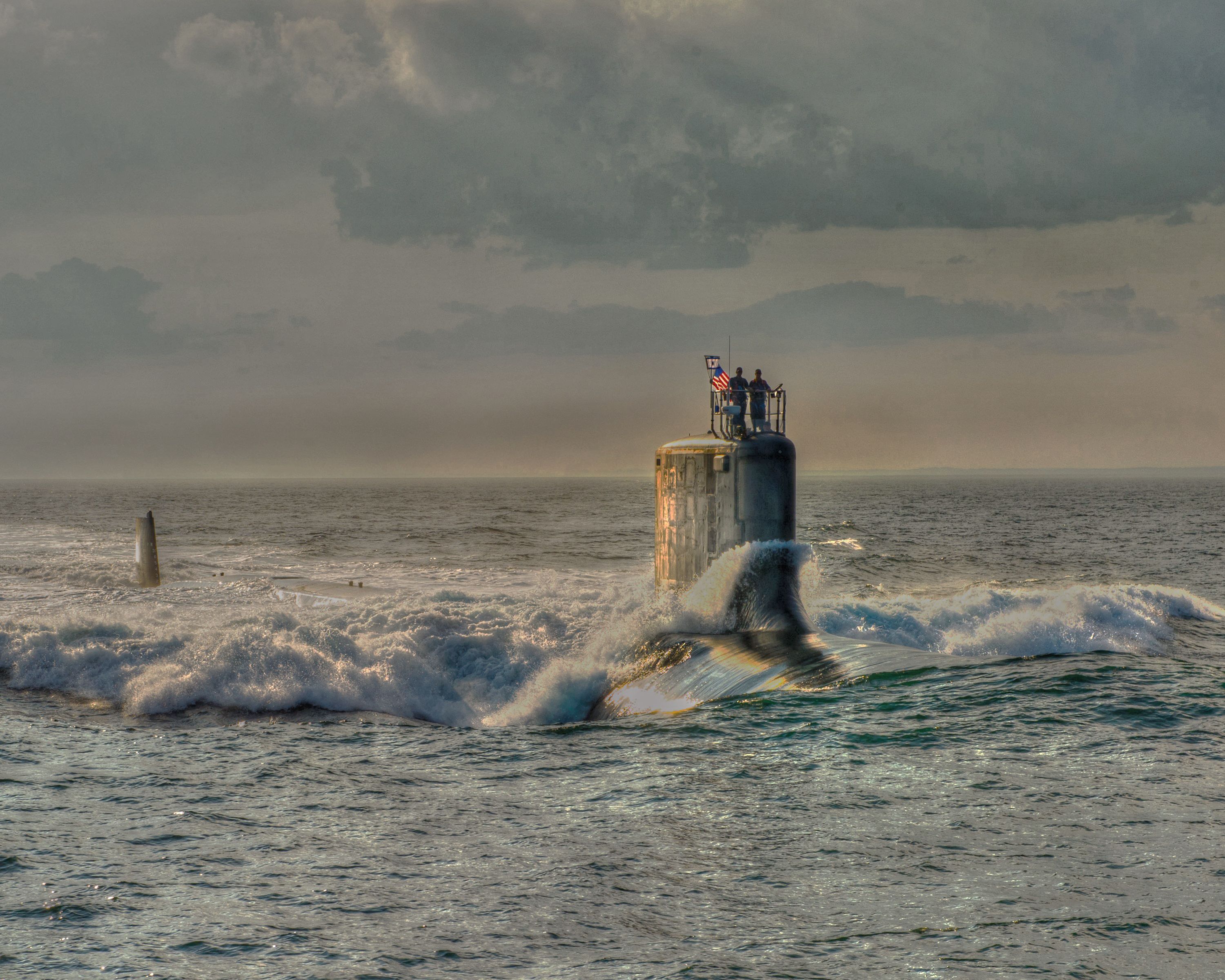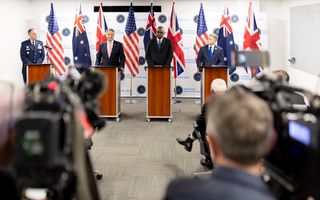The following report reflects the outcomes of the inaugural Track 1.5 “Foundations for AUKUS Pillar I Implementation” workshop, hosted by the United States Studies Centre in partnership with the Center for Strategic and International Studies and the Royal United Services Institute. More than 50 experts and officials convened at the Australian High Commission in the United Kingdom to generate insights on strategic, social license and workforce challenges shaping the implementation of the partnership.
Key findings
1. The broad value of AUKUS as a technology-sharing arrangement, defence industrial federation and deterrence partnership is agreed upon by Washington, Canberra and London. However, in other areas, the strategy driving cooperation is not well understood. Though complete alignment is not essential, officials from all three countries must undertake a more rigorous examination of the potential uses of AUKUS capabilities to consolidate shared overarching aims, as well as their own discrete national objectives.
- Leader-level statements need to become more frequent. The rationale for AUKUS capabilities must be better communicated to both the public and the bureaucracy in each AUKUS country, taking into account both national and trilateral strategic interests. This is especially important in the Australian case, where the degree of public awareness of the partnership, the costs incurred and disagreement over the strategic rationale is highest.
- The strategic thinking about the applications of AUKUS capabilities must account for the ways the regional and global strategic environment will change in the coming decades, to justify investments in a nuclear-powered submarine capability that is decades away.
- The rationale for AUKUS cooperation must be better internalised in the UK and Australian systems; the trilateral strategy shaping submarine cooperation must limit the single-minded focus on countering China that has characterised US thinking around the partnership. Instead, emphasis must be placed on the fact that AUKUS is centrally a technology-sharing agreement and the capabilities produced will be theatre-agnostic.

2. AUKUS is multigenerational and will depend on a degree of community support in Australia, the United Kingdom and the United States to succeed. That there is little awareness of the partnership in London and Washington, and amongst the Australian public opinion is mixed and inconsistent across opinion polls. This should be a clear call for action for the three governments to improve public awareness through the articulation of a clear strategic rationale for this technology-sharing pact.
- Senior officials should coordinate trilaterally on their approach to domestic strategic communications to avoid contradictions that raise concerns for other partners. For example, Australia’s focus on sovereignty and a view in the United States that their participation, particularly in Pillar II of AUKUS, is altruistic. For the United Kingdom greater clarity around the focus on capability not being linked to their Indo-Pacific tilt.
- As the three countries prepare for potential changes of government in the United Kingdom and the United States this year, trilateral engagement through the bipartisan political friendship groups in each country – the AUKUS Caucus in Washington, the Parliamentary Friends of AUKUS in Canberra, and the All-Party Parliamentary Group on AUKUS – should be encouraged. More robust coordination within the legislatures, taking full advantage of these groupings, can consolidate political-level support into the future.
- Despite the significant investment in the AUKUS program public engagement is limited to official statements and limited industry and community engagement. There is currently no dedicated avenue for universities or think tanks to seek funding for Track 1.5 dialogues and other forms of public engagement. This is critical as these groups bring academically rigorous and independent expertise and commentary to advancing public awareness, contestability and policy options for the enterprise at the national and trilateral levels. AUKUS projects and/or fellows - working on policy, technical areas, or public engagement programs - could be placed at various institutions in the three countries and AUKUS programs of study could be designed offering international exposure to enrich public engagement and contestability.
3. Workforce is the most daunting challenge to the implementation of AUKUS Pillar I, due to the extent of workforce shortages facing the submarine industrial bases in all three AUKUS countries. Experts agree about the interdependency between public support for the enterprise and worker recruitment at scale.
- A greater public literacy is required about what nuclear work entails across the supply chain. This will be important in all three countries, as the United States and the United Kingdom grow their nuclear industries, but especially in Australia where there is no baseline acceptance of nuclear within the workforce.
- Australian and UK unions and industry representatives were insistent that they must be brought ‘into the tent’ to assist governments in gaining fidelity on labour shortages and share best practices in the design of training and recruitment measures.
- Trilateral cooperation on technologies targeted at improving productivity at shipbuilding sites may soften the harsh edge of worker shortages in the future.
Introduction
Over the next three decades, Australia, the United Kingdom and the United States’ partnership on nuclear-powered, conventionally armed submarines (SSNs) will become increasingly pivotal for the three countries’ national strategies and their economies. The strategic documents released by all three countries underscore that AUKUS are a concrete demonstration of both integrated deterrence in the Indo-Pacific and their mutual commitment to trilateral development in key technology areas in an era of strategic competition. At the same time, the acquisition of SSNs will be the most significant defence procurement ever undertaken by the Australian Government. It guarantees a future UK SSN capability, and for Australia and the United States, focuses on their commitment to continued undersea dominance and the maintenance of a long-term strategic balance in the Indo-Pacific. It is unsurprising, then, that AUKUS has been deemed “too big to fail” by officials.1
A flurry of activity over the past year has demonstrated the partners’ determination to rise to meet the challenges of AUKUS Pillar I. Still, obstacles persist to the success of AUKUS at the speed of relevance over the project’s life. For all three countries, updating national strategies, building social license and training workers are long-term challenges requiring tailored national solutions. Partnership through AUKUS is an opportunity to learn from trusted allies and formulate coordinated solutions to problems faced in implementing Submarine Rotational Force-West (SRF-W), the transfer of Virginia-class submarines and the design of the SSN-AUKUS. A commitment to deterrence and the maintenance of a strategic balance by working closely with allies and partners already sits at the heart of Australian, UK and US strategic policy.
This report premises its assessment of challenges to trilateral AUKUS Pillar I implementation on an evaluation of progress made to date in nuclear-powered submarine cooperation. Drawing upon insights from a dialogue with experts and officials from all three countries, it then examines national approaches to developing and aligning strategies, building community understanding and support, and identifying and training the workforce. Each section features recommendations to the three governments to underwrite successful cooperation into the future as proposed by experts present at the workshop.
Inroads made into the optimal pathway
Since the pathway to a common UK-Australia ‘SSN-AUKUS’ was announced in March 2023, officials have acted with haste to take the initial steps towards implementation.2 Three to four years of effort at a business-as-usual pace has been achieved in a matter of only as many months. In this first stage of cooperation, officials’ energy has been primarily devoted to creating the bureaucratic architecture to deliver the capability, dismantling legislative barriers and taking an expeditious approach to workforce development to prepare for the rotational deployments of US and UK submarines to Western Australia’s HMAS Stirling naval base from 2027.
1. Governance
Over more than two years, the three countries’ defence bureaucracies have established senior positions commensurate to the importance of the AUKUS undertaking. In the United States, AUKUS implementation prior has been primarily stewarded by the Senior Advisor to the Secretary of Defense for AUKUS within the Department of Defense to date. In recent months the United States has moved to diffuse responsibility for both AUKUS Pillars between officials in the Pentagon, White House and US Navy – embedding the program into the bureaucracy. This represents a baking of AUKUS delivery into the US Department of Defense and its adoption as ‘business as usual’ for the system following the passage of the 2024 National Defense Authorisation Act (NDAA). In the United Kingdom, AUKUS has been moved from the remit to the National Security Cabinet to the Ministry of Defence. A new full-time role, Director General – AUKUS, was created in 2023 with responsibility for all aspects of the partnership. Responsibility for AUKUS’s two lines of effort is also divided in Australia. Following the recommendations of the 2023 Defence Strategic Review, Mr Stephen Moore drives AUKUS Pillar II projects as First Assistant Secretary of Defence for AUKUS advanced capabilities, while Vice Admiral Jonathan Mead, who serves as Director General of the Australian Submarine Agency (ASA), drives Pillar I.3 The creation of the ASA is the most significant of these institutional structures, reflective of the significant uplift in capability that AUKUS Pillar I provides to the Australian Defence Force.
Advocacy groups for AUKUS have emerged in the legislatures of all three countries to progress AUKUS efforts at the political level. The US AUKUS working group, better known as the AUKUS Caucus, was the first cab off the rank, founded in early 2022 with strong bipartisan support.4 Members of this caucus have been champions of important legislative changes to US policy, including reforms to the International Traffic in Arms Regulations (ITAR) to remove obstructions to unprecedented technology transfer from the United States to its AUKUS partners.5 In the United Kingdom, an All-Party Parliamentary Group was launched in July 2023 to better understand both the opportunities and challenges of the SSN-AUKUS program.6 An Australian body was created without fanfare more recently as a non-partisan forum for parliamentarians to facilitate discussion around aspects of the AUKUS partnership and to engage with their US and UK equivalents.7
AUKUS progress has been spearheaded, from the outset, by the three heads of state. Experts report that leaders’ level directives have been the key catalyst in unlocking AUKUS cooperation at pace. The leaders have only convened once in person since the announcement of AUKUS when they unveiled the ‘optimal pathway’ for Pillar I in March 2023. Given the difficulty of scheduling leaders’ travel, this is by no means surprising; future leaders’ meetings can be expected primarily on the sidelines of multilateral meetings.
After a protracted synchronisation arrangement, the Australian and UK Defence Ministers and the US Defense Secretary have also met on two occasions, most recently in December 2023.8 Pre-empting continually over-burdened agendas and changes to position occupants, AUKUS progress would benefit from commitments to regularised engagements of relevant ministers and senior bureaucrats where possible to maximise the benefits of high-level attention.
Below the ministerial level, AUKUS country officials convene regularly. The UK Foreign, Commonwealth and Development Office works closely with Australia’s Department of Foreign Affairs and Trade on AUKUS implementation. After a reportedly stilted start, the US State Department is also increasingly engaged with its counterparts. Given the scale of the task and the high degree of priority placed on AUKUS in the Australian system, as the recipient of a new capability in the form of a fleet of SSNs, it is unsurprising that the bench of officials working on AUKUS issues in Australia exceeds that in the United States and the United Kingdom.
2. Policy settings
Sharing the “crown jewels” of US defence technology demands a tremendous amount of trust. To enable this collaboration, the US, Australian and UK legislatures have demonstrated a willingness to bend or indeed break their systems to ensure the AUKUS partnership is realised demonstrating that bipartisan support at the legislative level is just as important as leader-level agreement to the continuation of AUKUS cooperation.
The passage of the US 2024 NDAA on 15 December 2023 offered long-awaited authorisations to enable AUKUS cooperation. Since AUKUS was first announced, experts warned that left un-reformed, the “outdated”, “confusing and challenging” regulatory settings of US ITAR would threaten the realisation of AUKUS.9 The NDAA contained a “powerful national exemption” to the cumbersome export license controls for Australia.10 Importantly, this exception is not confined to the AUKUS project; the addition of Australia into Title III of the US Defense Act opens new opportunities for Australia-based industry partners to seek business from the US Government.
In addition, the 2024 NDAA included provisions for the transfer of Virginia-class submarines to Australia, the transfer of funds from Australia to the United States to support the US submarine industrial base, and approval for Australian contractors to train in US shipyards. In the face of continued internal debates in the United States about the transferring of a scarce capability at a time of strategic need, these are a significant demonstration of American resolve and their commitment to the strategy of integrated deterrence. It should, though, be acknowledged that the passage of enabling legislation through US Congress remains subject to domestic political obstacles; while the NDAA secured bipartisan approval it has faced long delays in its appropriation, as has the National Security Supplemental, an important additional allocation containing funding for the US domestic submarine industrial base.11

In recent months, legislation was also introduced in Australia to alter its export and information security restrictions. It is broadly acknowledged that the catalyst for the Defence Trade Controls Amendment Bill 2023, introduced in November 2023, was an acknowledgement by Australian officials of the need to satisfy US expectations about information security for AUKUS cooperation to continue. The proposed law will establish the military equivalent of a free trade zone with Australia’s AUKUS partners and will strictly penalise unauthorised technology sharing.12 Though the legislation has been criticised by some corners for being cumbersome or containing some sovereignty concerns,13 it is generally regarded by experts as a necessary precursor to Australia getting “in the tent” on highly classified US military technology. It is worth noting that the US research and development sector, the leading innovation ecosystem in the world, has been able to operate under rigorous regulation. US researchers in the defence and dual-use sector continued to pursue global research partnerships built around basic research outcomes while protecting sensitive technologies. Still, Australian universities are right to be cautious while the conditions of Australia’s bill are shaped; clear exemptions for fundamental research and clear definitions for this research must be legislated in the revised Australian Defence Trade Controls Amendment Bill.
3. Preparing industry
A constellation of national and tri-national initiatives are coalescing to prepare US, UK and Australian companies and workers. The most animated trilateral effort has been around training the Australian naval and industrial workforce. Six Australian Navy officers have graduated from the US Naval Nuclear Power Training Command and Nuclear Power School since July 2023.14 As of September 2023, there were five Australian military personnel embedded in the UK military: three with the Royal Navy within the Submarine Officer Nuclear Training pipeline, and two within the MOD’s Submarine Delivery Agency and the Defence Nuclear Organisation. Thirteen personnel in Australia’s industrial workforce have completed a seven-week training and familiarisation program in the United Kingdom working with UK defence industry partners Rolls Royce, BAE Systems and Babcock.15 These initiatives offer much-needed experience to Australian workers and may serve to “train the trainers” for a larger sovereign Australian workforce.
In 2023, preliminary efforts were made to expedite Australia’s workforce development at the national level. The Australian Government and its state-level counterparts have sought to expedite worker recruitment and training through a state of local initiatives that hold some promise in that regard. In 2023, the South Australian Government released its Defence Industry Workforce and Skills Report, unveiling efforts to engage an estimated 27,000 students and 1,500 teachers to support STEM education pathways, expand the Early Careers Program and improve workforce data and insights across industry and government among others.16 Still, industry continues to report tremendous difficulties in finding and retaining skilled workers. Recruitment barriers, including competition from adjacent industries, are poised to increase.
With AUKUS projects in Australia projected to demand 8,500 industrial workers and with the immense crewing requirements of US Virginia-class submarines,17 the current scale of training would not make a dent in Australia’s skills and training challenge, especially to meet near-term challenges of SRF-W and infrastructure construction in South Australia. Workforce shortages persist in all three countries. The US National Defense Industrial Strategy flagged that the US submarine industrial base will require an additional 100,000 trained workers and 17,000 supply chain workers over the next decade.18 The UK shipyard workforce needs to grow from 10,000 to 17,000 by the end of the decade.19 In Australia, the recruitment of workers into shipbuilding faces significant structural issues. Record low levels of unemployment, national skill shortages in key trades and professionals, plummeting apprenticeship completion rates and demand for the same or adjacent skills from the mineral and resources sector, and the clean energy transition have prompted the Labor Government in 2024 to announce a ‘Strategic Review of the Australian Apprenticeship Incentive System’ and the outcomes of the “Australian Universities Accord Final Report Document” which contains 47 recommendations for Government consideration. Most significantly this report noted that:
Jobs and Skills Australia (JSA) anticipates that over the next decade, more than 90% of new jobs will require post-school qualifications. This includes around 50% requiring bachelor degree or higher qualifications and 44% requiring VET qualifications. Further, evidence prepared for the Review by Oxford Economics Australia suggests that 90% of 25 to 34-year-olds will require a tertiary education by 2050.20
Australian industry awaits the Government’s announcement of the AUKUS design and sustainment partners, as well as the outcomes of the promised defence industry development strategy that will set the terms for AUKUS recruitment efforts going forward.21 An upcoming trilateral announcement promises to provide clarity for industry organisations in each country that have been awaiting their role in the enterprise across the supply chain.
The long road ahead
1. Aligning strategies in an evolving strategic context
Developing and sustaining a clear, shared vision for the purpose of AUKUS nuclear-powered submarines is crucial to drive cooperation and direct the use of resultant capabilities. Some key strategic effects of AUKUS are well-understood in the three capitals: AUKUS enables invaluable technology-sharing, it brings trusted partners in the region into closer coordination while contributing to deterrence, and it unlocks sweeping defence industrial cooperation into the future. Clarity throughout the three government systems on these shared overarching requirements will drive AUKUS cooperation into the future, even as each country also pursues limited national objectives.
Undoubtedly, the SSN-AUKUS would represent a powerful hedge against any strategic competitor’s next-generation submarine capability and contribute to deterrence. AUKUS accords closely with the stated ambitions of the three countries’ most recent strategic documents. For the United Kingdom, AUKUS features prominently in its 2023 Integrated Review Refresh.22 AUKUS cooperation serves to manifest a global role for Britain and forms part of a broader resetting of the UK-US relationship. The aims laid out in Australia’s 2023 Defence Strategic Review, namely a “strategy of deterrence through denial, including the ability to hold any adversary at risk” and a “focus on asymmetric advantages”, align closely with AUKUS cooperation outcomes and must be better understood throughout Australia’s public service and by the public.23 For the United States, AUKUS is among the most significant moves made to realise the Biden administration’s vision of “integrated deterrence” as laid out in the 2022 National Defense Strategy.24
Elsewhere, however, the strategic logic driving AUKUS partners’ participation in the enterprise diverges or is disputed at the national level. For the United Kingdom, AUKUS is about deterrence, but it is not strictly about China. The future use of AUKUS capabilities is contested in the UK system. AUKUS embodies, in some respects, a long-standing UK ambition to engage more strongly in Asia, that has been extant since before the 2023 Integrated Review, the 2021 ‘tilt to the Indo-Pacific’ or even the 2018 ‘Global Britain’ approach. Still, there is tension in the United Kingdom regarding concentrating its workers and resources on a next-generation submarine capability focused on the Indo-Pacific rather than its near region. Though the overall cost to the United Kingdom has not been specified, the Government has committed £3 billion to the SSN-AUKUS programme and the Defence Nuclear Enterprise (DNE) over the next two years.25 Experts warned that irrespective of their involvement in AUKUS, the United Kingdom will continue to prioritise the threats posed by Russia and limit its material commitments in the Indo-Pacific, especially under a new government. Consequently, most British experts agreed that there is a risk associated with over-identifying AUKUS with an Indo-Pacific tilt and balancing China. AUKUS accords with broader, bipartisan efforts to advance UK capabilities beyond the land domain. Importantly, submarines are a theatre-agnostic capability that can just as easily be deployed in the Euro-Atlantic, which will ensure successive governments more sceptical of the Indo-Pacific tilt remain convinced of the need for AUKUS cooperation.

Australian experts noted that, where the strategic rationale for AUKUS is broadly agreed upon within the Department of Defence, political-level officials and the national community are less aligned. Direct public statements by officials regarding the strategic logic driving Australia’s procurement of nuclear-powered submarines have been few and far between.26 The difficulty of reconciling AUKUS with a simultaneous project to achieve a diplomatic reset with China is a partial explanation for the Government’s difficulties to date with prosecuting the strategic rationale to the Australian public. The Chinese Communist Party’s coercive behaviours are yet to be explicitly named by senior officials as the key motivating factor for Australia’s acquisition of nuclear-powered submarines. Instead, leaders have focused on changes in the balance of power in the Indo-Pacific and the deterioration of the strategic environment, resulting in ‘the most challenging strategic circumstances since the Second World War’.27 Though even critics of the partnership agree that a submarine capability is essential for Australian defence, experts remain concerned about the role AUKUS compels for Australia in a future conflict.28 With nuclear-powered submarines dramatically increasing Australia’s operating endurance, AUKUS cooperation inspires a host of questions about potential uses of this capability, especially against a country with whom Australia and other partners in the region retain extensive trade links. While an SSN capability dramatically increases Australia’s ability to execute its declared strategic focus on deterrence and its military strategy of denial for national defence in Australia’s northern approaches, detractors have used the enhanced capabilities of conventional armed nuclear-powered submarines and a lack of strategic messaging from the government to argue that Australia is conspiring to use this capability to erroneously support US hegemony in the region despite the Defence Strategic Review clearly stating that this era in the Indo-Pacific has indeed ended.29
Of the three countries, the strategic logic for AUKUS is most straightforward for the United States. Though Canberra was the initiator of this partnership, US experts emphasised that the arrangement only exists because it also serves and enhances US strategic objectives. The Biden administration is acutely aware that the United States cannot affect deterrence in the Indo-Pacific alone and that threats are best addressed far from US shores. AUKUS is one of several examples of the administration’s efforts to strengthen the capability of its closest partners including new cost-sharing arrangements with Japan and the Republic of Korea and the announcement of new Enhanced Defence Cooperation Agreement sites with the Philippines. Initial questions from partners about US capacity to resource AUKUS while addressing conflicts in Europe and the Middle East, have subsided somewhat, and have been superseded by domestic-level concerns about US industrial policy and electoral politics. The greatest strategic question for US policymakers, which has intensified in recent months, is whether deterrence is best served by a larger national capability or through the empowerment of US allies. A Congressional Research Service report surfaced the concern that a dip in the US SSN force through the sale of Virginia’s could cause operational strain and weaken conventional deterrence.30
Strategy session conclusions
The broad value of AUKUS as a technology-sharing arrangement, defence industrial federation and deterrence partnership is agreed upon by Washington, Canberra and London. However, in other areas, the strategy driving cooperation is not well understood. Though complete alignment is not essential, officials from all three countries must undertake a more rigorous internal examination of the potential uses of AUKUS capabilities to consolidate shared over-arching aims.
- Leader-level statements need to become more frequent. The rationale for AUKUS capabilities must be better communicated to both the public and the bureaucracy in each AUKUS country, taking into account both national and trilateral strategic interests. This is especially important in the Australian case, where the degree of public awareness of the partnership, the costs incurred and debate over the strategic rationale is highest.
- The strategic thinking about the applications of AUKUS capabilities must account for the ways the regional and global strategic environment will change in the coming decades, to justify investments in a nuclear-powered submarine capability that is decades away.
- For the rationale for AUKUS cooperation to be better internalised in the UK and Australian systems, trilateral strategic thinking must limit the China centrality that has characterised US thinking around the partnership. Instead, emphasis must be placed on the fact that AUKUS is centrally a technology-sharing agreement and the capabilities produced will be theatre and threat-agnostic.
2. Growing public support to sustain the partnership
Experts agreed that the realisation of AUKUS at the speed of relevance will depend on acceptance of the partnership among both local and national publics. As things stand, public support for cooperation on nuclear-powered submarines in each country is either stagnant or, in Australia’s case, on a downward trajectory. Experts conceded that this lack of community support or social license for AUKUS would likely slow progress. Subjecting AUKUS to greater public discussion is a positive development that will help to embed AUKUS in the strategic culture of all three nations over the next three decades. Public concerns should be anticipated and proactively addressed by the three countries’ senior officials.
At the political level, experts remain confident of staunch bipartisan support for AUKUS cooperation in each of their countries. Already, AUKUS has survived changes in leadership in both Australia and the United Kingdom. Some key concerns of centre-left Australian sceptics, prominent in the media in the aftermath of major AUKUS announcements, were addressed at the 2023 Australian Labor Party National Conference, where AUKUS was cemented in the party’s national platform.31 In the United Kingdom, AUKUS is foundational to a “levelling up” agenda for defence prosperity across the country, which will in turn guarantee support even under a likely changed government later this year.32 In the United States, AUKUS has been strongly connected with US competitive advantage in strategic competition – one of the few areas of bipartisan agreement in an otherwise polarised political system. The greatest tension for social license at the political level in the United States is the logic of selling a scarce capability in a time of need. American experts in attendance concurred that the idea that strengthening the capability of US allies is of utmost importance has taken hold in the US system.33 However, the possibility remains after the 2024 election that a future president less hospitable to the idea of the empowerment of allies may introduce new questions for AUKUS at the political level.
At the public level in all three countries, social license challenges persist. In Australia, experts observed that a lack of broad public support for AUKUS cooperation is a major point of concern. While the Lowy Poll maintains 67 per cent public approval for AUKUS, a number of surveys suggest that Australians’ support for nuclear-powered submarines has softened since the partnership was announced.34 Only 33 per cent of young Australians think it’s a good idea for Australia to have nuclear-powered submarines, down from 43 per cent in 2022.35 Concerns about Australia’s sovereignty within the partnership, the degree of uncertainty contained in the long-term roadmap, and the risks of a second Trump presidency have surfaced often in Australian media.36 In addition, the cancellation of the French submarine program in favour of the promise of (as-yet) hypothetical AUKUS jobs has produced significant cynicism among Australian shipbuilding and manufacturing workers who must be recruited into the AUKUS enterprise. Public scrutiny around cost and nuclear safety, latent for now, is sure to emerge and could impede progress. The Australian government has thus far refrained from developing public conversation about nuclear safety, emphasising the long timeframe of the nuclear component of submarine cooperation, leaving the partnership vulnerable to conjecture.37 The above notwithstanding, the Australian public is generally supportive of working with allies and partners, and a strong majority of Australians continue to feel Australia’s US alliance makes them safer.38

Experts and officials observed that public awareness of the AUKUS partnership in the United Kingdom and the United States is not commensurate with the significance of the undertaking. CT Group finds that fewer than a quarter of those polled in the United Kingdom and the United States are aware of AUKUS cooperation – where more than half of Australians were familiar.39 Nonetheless, there is a strong basis for public support; 64 per cent of British people believe working with allies on projects like AUKUS makes the United Kingdom safer and 65 per cent think technology collaboration helps the United Kingdom to compete with China.40 Polling also finds broad support in the United States, though a significant contingent of the public remains unsure about or unfamiliar with the partnership.41 Experts assessed that universities and think tanks in the United Kingdom and the United States are yet to be seized by the opportunities entailed in AUKUS cooperation. UK university representatives report limited engagements thus far with officials around AUKUS.
Social license in the local communities around shipyards is distinct from broader national support. British experts reflected on the United Kingdom’s significant experience building a social contract with the community around shipyards at Barrow in Furness. Three out of five people in the local working population in Barrow are principally employed in shipbuilding, and there is generally an understanding and a level of acceptance of the risks associated with a nuclear project. Important factors in enhancing social license in the United Kingdom’s case have been a clear economic proposition to the community and transparent communications around nuclear safety that build trust over time. Australian officials have similarly concentrated their engagement efforts on the communities around shipyards in South Australia and Western Australia. However, the undeniably distinct nature of the relationship between the shipyard and the community at Barrow makes the United Kingdom an imperfect analogue for an Australian approach to social license.
Social license session conclusions
AUKUS is multigenerational and will depend on a degree of community support in Australia, the United Kingdom and the United States to succeed. That there is little awareness of the partnership in London and Washington, and that Australian public opinion is mixed and inconsistent across opinion polls, should be a source of concern for the three governments.
- Senior officials should coordinate trilaterally on their approach to domestic strategic communications to avoid contradictions that raise concerns for other partners. National level doubts the partners should be sensitive to include, for example, Australian sovereignty requirements and a view in the United States that their participation, particularly in Pillar II of AUKUS, is altruistic.
- As the three countries prepare for a potential change of government in the United Kingdom and the United States, trilateral engagement through the bipartisan political friendship groups in each country – the AUKUS Caucus in Washington, the Parliamentary Friends of AUKUS in Canberra, and the All-Party Parliamentary Group on AUKUS – should be encouraged. More robust coordination within the legislatures can consolidate political-level support into the future.
- There is currently a shortage of dedicated avenues for think tanks and universities to gain funding for Track 1.5 dialogues and other forms of research and public engagement, that will be instrumental in advancing public awareness, contestability and policy options for the enterprise at the national and trilateral level. AUKUS fellows could be placed at think tanks and universities in the three countries and AUKUS programs of study could be designed offering international exposure to enrich public engagement.
3. Rising to the workforce challenge
Participants agreed that identifying, training and retaining the workers to sustain AUKUS cooperation is the foremost challenge to the realisation of AUKUS. In the Australian setting, this is especially true of the daunting near-term requirements of SRF-W. The scale of the requirements of AUKUS will exaggerate existing shortages in Australia’s public services, militaries and industrial workforces. Warning alarms have sounded since the optimal pathway was announced.42 US shipyards are showing signs of strain. The Virginia-class program faced extensive delays, and reportedly the Pentagon’s FY2025 budget request will halve their standard ask for Virginia-class submarines.43 In the United Kingdom, the Shipbuilding Skills Taskforce’s 2023 inquiry into the existing workforce discovered negative perceptions of the sector and barriers to the recruitment and training of apprentices persist.44
Though trilateral efforts previously canvassed in this report are useful, they represent only a partial solution. More ambitious industrial worker exchanges are being explored but will be problematised in the near term by policy settings and in the future by skills shortages at home and concern for the poaching of workers by AUKUS partners.45 Accordingly, greater public clarity on AUKUS partners’ non-poaching commitments is an important first step from unions’ perspectives.
At the national level, both the United States and the United Kingdom have implemented an array of initiatives to improve recruitment and retention, especially in their industrial workforce, that could be instructive for Australia. In the United Kingdom, BAE’s Skills Academy has provided the foundation for workforce resilience. Industry representatives in attendance highlighted industrial tourism and the creation of apprentices targeted at the local community as successful drivers of young people and women. The US government has invested heavily in an effort to resolve workforce problems. The most recent presidential budget request for FY2025, while cutting the annual order for Virginia-class submarines from two to one, asks for an additional US$3.9 billion within that year and US$11.1 billion over five years for the submarine industrial base.46 In addition, Australia is contributing US$3 billion to the US submarine industrial base. The US ethos that productivity gains can offset quantitative requirements is an interesting model for Australia, which requires creative solutions to maximise the value of its smaller labour force.
The workforce challenge is greatest for the Australian government, which must prepare a sovereign enterprise without an existing major shipbuilding or manufacturing industry to draw upon. Though Australia has a considerably smaller overall population, Australian attendees insisted that the core problem was not a lack of workers available in the local community. In all three countries, the greater challenge is the unique challenges shipbuilding work presents for worker attraction. More Australians have bachelor’s degrees than US and UK citizens by a wide margin. Twenty-seven per cent of Australian graduates come from overseas, compared with 5 per cent in the United States. In Australia, the defence industry and the government will be competing with the resources sector and the energy sector for qualified workers. The United Kingdom and the United States will be navigating the simultaneous demands of multiple capabilities and civil nuclear revivals.
It was remarked repeatedly that recruitment into shipbuilding today relies upon a ‘pride factor’ in the local community, which Australia will struggle to replicate given its history of abortive shipbuilding. In discussing the prospects for Australia to replicate the sense of pride felt in the British shipbuilding sector, officials commented that Perth and Adelaide are the two Australian cities with the highest per capita British population and speculated whether this fact could provide a bedrock of public support for the partnership and worker exchanges. Social license, in many regards, will be deterministic to recruitment efforts at speed and scale.
Workforce session conclusions
Workforce is the most daunting challenge to the implementation of AUKUS Pillar I, due to the extent of workforce shortages facing the submarine industrial bases in all three AUKUS countries. Experts agree about the interdependency between public support for the enterprise and worker recruitment at scale.
- A greater public literacy is required about what nuclear work entails across the supply chain. This will be important in all three countries, as the United States and the United Kingdom grow their nuclear industries, but especially in Australia where there is no baseline acceptance of nuclear within the workforce.
- Australian and UK unions and industry representatives were insistent that they must be brought ‘into the tent’ to assist governments in gaining fidelity on labour shortages and share best practices in the design of training and recruitment measures.
- Trilateral cooperation on technologies targeted at improving productivity at shipbuilding sites may soften the harsh edge of worker shortages in the future.




.jpg?rect=0,80,3000,1989&fp-x=0.5&fp-y=0.44772296905517583&w=320&h=212&fit=crop&crop=focalpoint&auto=format)




